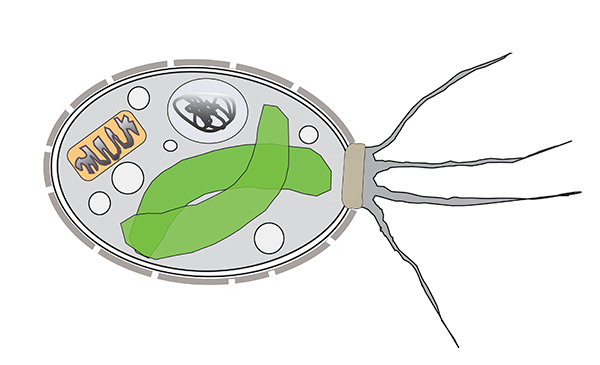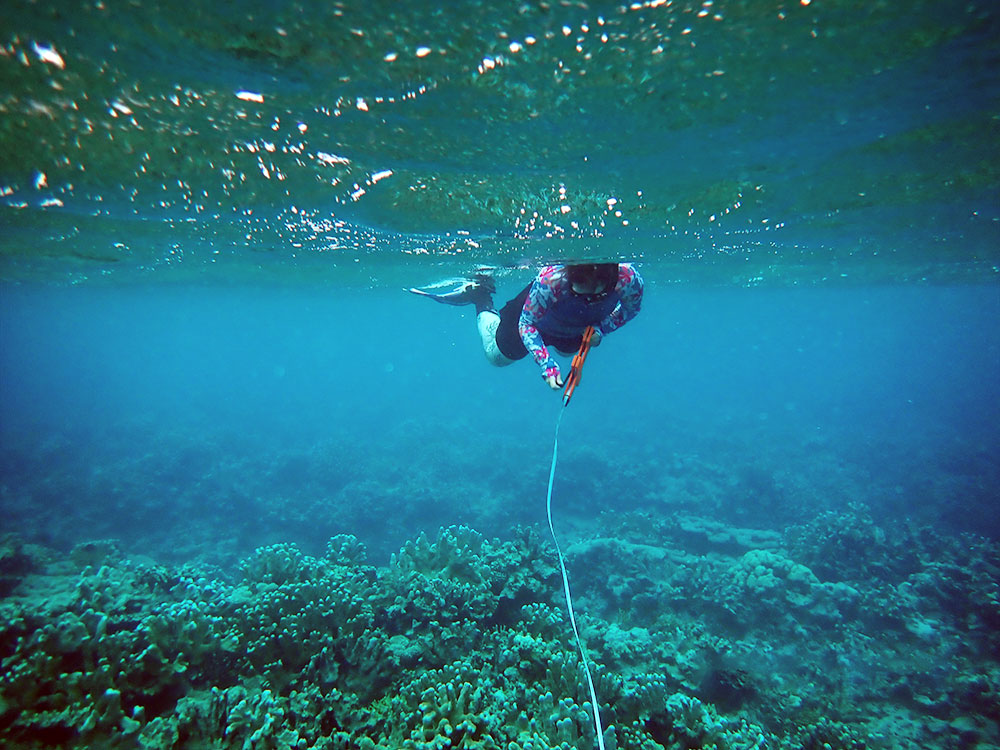
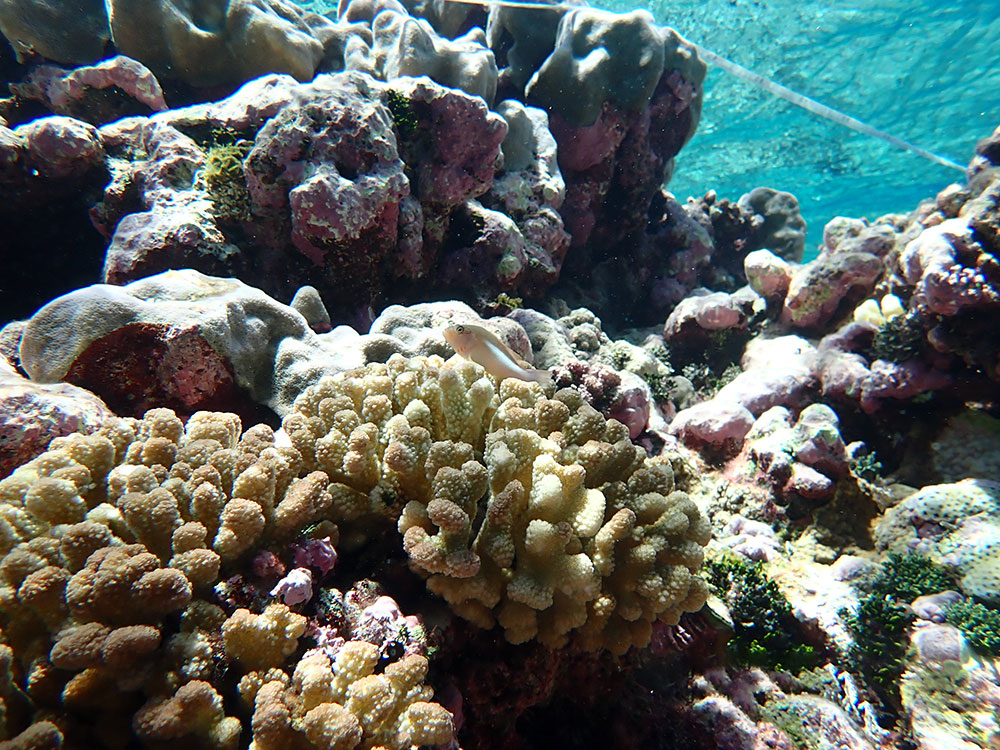
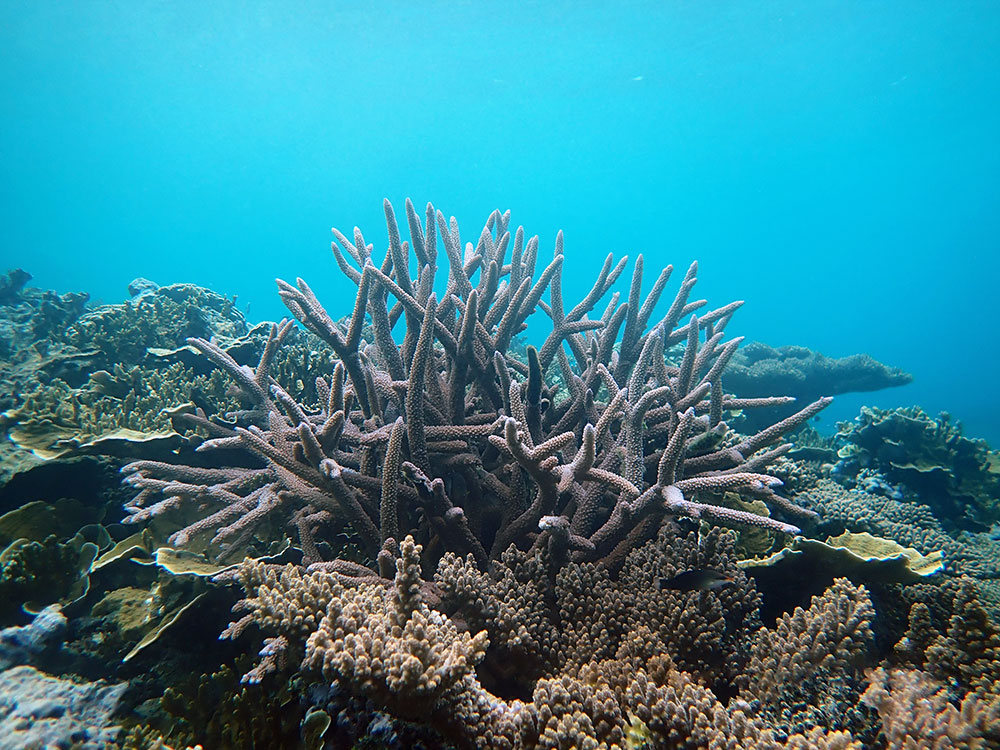
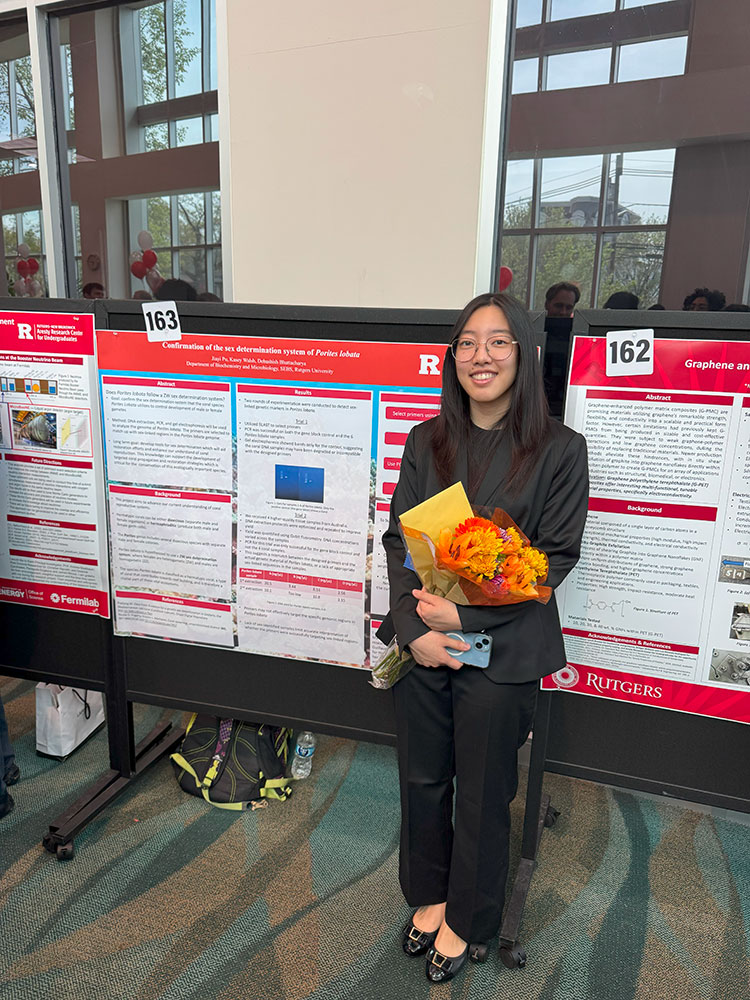
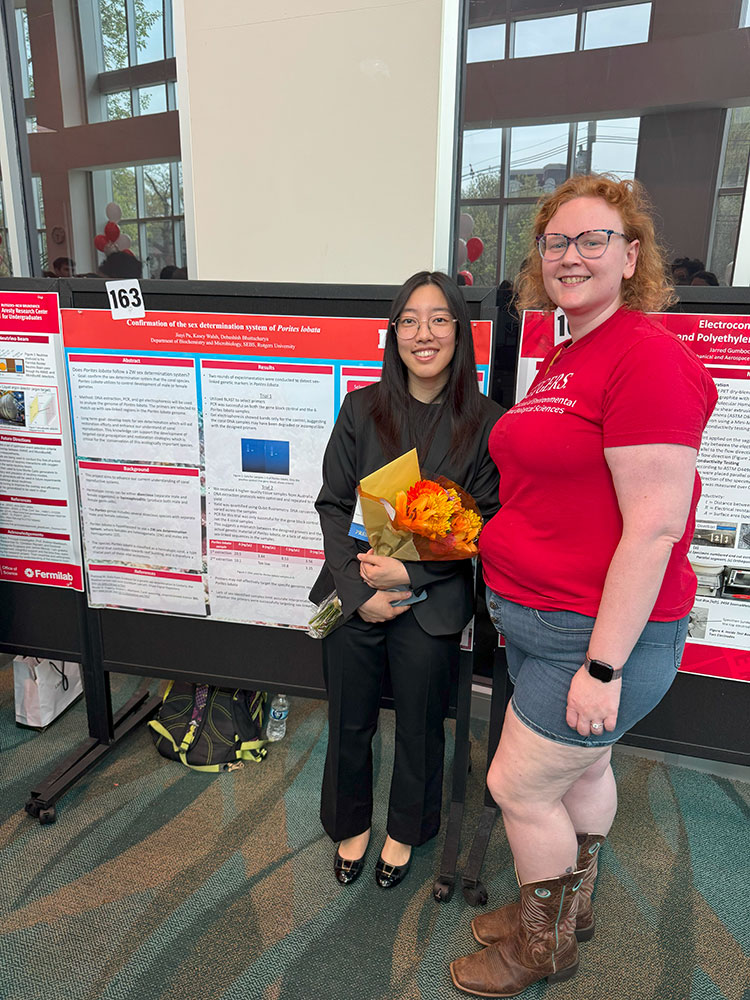
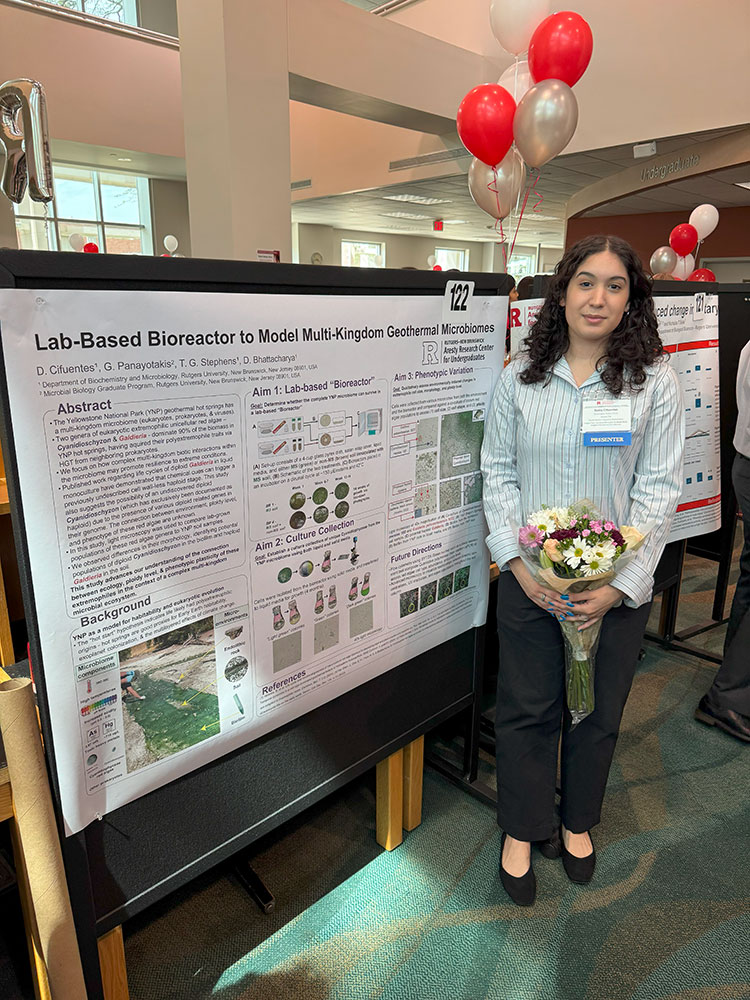
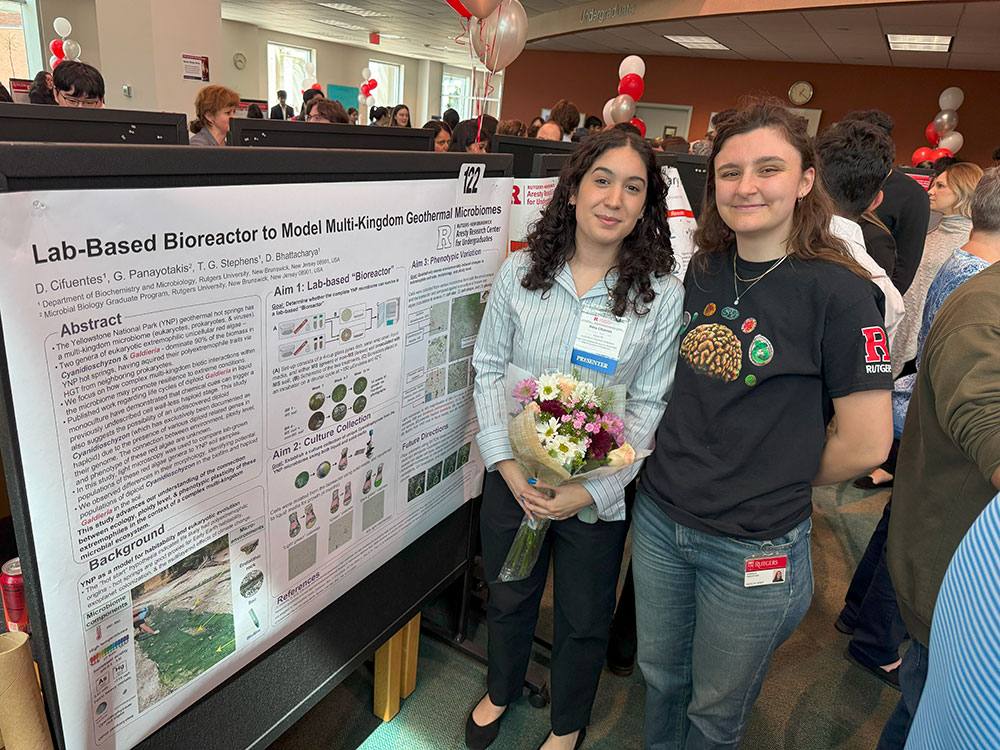
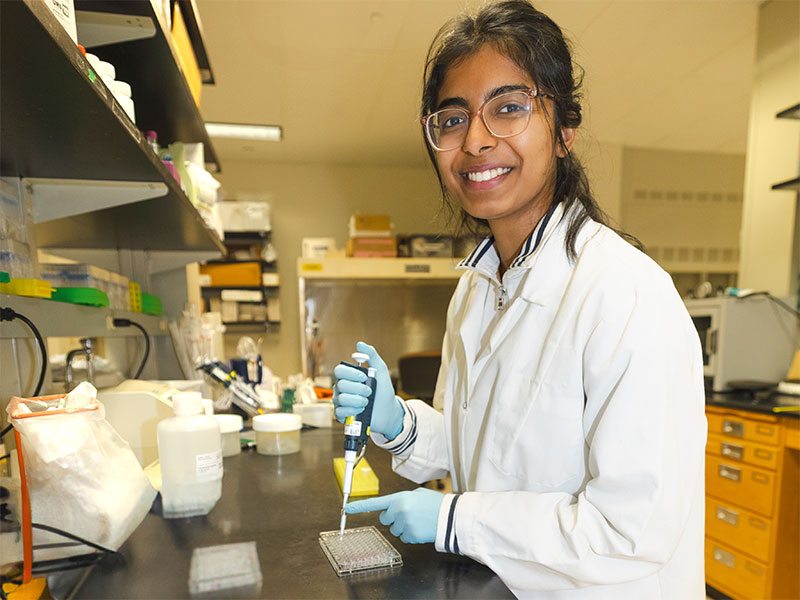
Shriya is a senior in the SEBS Biotechnology program, general option. As a New Brunswick Honors College student, she started her undergraduate research on corals in the Bhattacharya Lab in her junior year through the Aresty Research Assistant program. She continued her work with paid summer internships, and by pursuing her G.H. Cook Honors Thesis.
Shriya’s research in the Coral Hospital initiative is to test and validate whether health test kits that are developed for humans can be used on marine species, using corals as the initial test case. Corals suffer from warming oceans that can result in “bleaching” (loss of algal symbionts) and are also prone to devastating diseases such as Stony Coral Tissue Loss Disease (SCTLD) that has eliminated coral reefs in Florida and spread throughout the Caribbean region.
The research Shriya presented to the program described the testing of specific chemicals in coral tissues that act as markers of reef health. She has adapted the popular Urinalysis test kit developed to diagnose human health to corals. This approach offers a rapid and inexpensive way to assess how corals are faring in the field. The coral results are being validated using quantitative metabolomics with collaborators at the core center of the Rutgers Cancer Institute.
Shriya’s mentor, Ecology and Evolution graduate program student Erin Chille, suggested to her to apply for the D.O.O.R.S. program. It is a nationwide Mentorship and Scholarship Program, which aims to recognize and empower 10 undergraduate students each year in life science who represent underrepresented groups. It is funded by Promega and the BioPharmaceutical Technology Center Institute (BTC Institute). The scholarship supported Shriya’s tuition and advanced her research skills via the Biotechnology major. The award also includes a Mentorship Program with a professional from the biotech industry, and participation in D.O.O.R.S. Scholar’s Day 2025, an in-person event held at the BTCI / Promega campus in Madison, WI.
This video production explains the hypotheses “primary endosymbiosis accelerates lineage divergence” which was published in context with the Bhattacharya lab publication
Endosymbiotic ratchet accelerates divergence after organelle origin
The Paulinella model for plastid evolution
Debashish Bhattacharya, Julia Van Etten, L. Felipe Benites, Timothy G. Stephens
https://doi.org/10.1002/bies.202200165
On August 10, 2022 Arwa Gabr successfully defended her PhD thesis, entitled,
“LIGHT AND LIFE: EVOLUTION OF PHOTOSYNTHESIS AND LIGHT USAGE IN PHOTOSYNTHETIC PAULINELLA.”
ABSTRACT
The uptake and conversion of a free-living cyanobacterium into a plastid (site of photosynthesis in eukaryotes) is undoubtedly one of the most important innovations that changed the evolutionary trajectory of life on our planet. Transforming the biosphere, plastid primary endosymbiosis laid the foundation for terrestrial life and the evolution of multicellularity. Therefore, a massive effort has been expended to elucidate plastid origin, function, biogenesis, diversity and its impacts on global primary productivity and geochemical cycles. A more recent case of plastid origin (ca. ~124 million years ago) occurred in the thecate amoeba Paulinella that acquired a plastid (referred to as the chromatophore) from an alpha-cyanobacterial endosymbiont. Evidence suggests that although these protists contain a bona fide photosynthetic organelle, these compartments are a “work-in-progress” with regard to plastid integration, making the Paulinella lineage an ideal model for studying the evolution of primary endosymbiosis. In my doctoral research, I investigate the evolutionary adaptation to light and photosynthesis with a focus on host control of photosynthetic performance in photosynthetic Paulinella(specifically, P. micropora strain KR0I, also referred to as, KR01). My work shows that the amoeba host undergoes massive genetic reconfiguration, generating genetic novelty and evolving key traits in order to accommodate and control the photosynthetic organelle. As an example, one of the earliest host contributions to chromatophore evolution in KR01 was the rescue of chromatophore functions by the targeting of 291 nuclear-encoded proteins to the photosynthetic organelle via a novel chromatophore-targeting peptide (crTP). Evolution of this targeting system is not the only significant example of genetic innovation in photosynthetic Paulinella. In fact, analysis of genomic and transcriptomic data from KR01 suggests that this lineage independently evolved a mechanism for nuclear mRNA regulations termed spliced leader trans-splicing (SLTS). Playing a role in the integration of novel “dark” genes and genes of foreign origin acquired via EGT or HGT in KR01, SLTS can alter protein sequence and is hypothesized to generate genetic novelty that can be acted upon by natural selection to facilitate chromatophore integration. Genomic and transcriptomic analyses also revealed that loss of endosymbiont genes results in host “rescue” to facilitate organelle integration. This process was observed in nucleotide synthesis and DNA replication, whereby a handful of genes that encode key enzymes were lost from the endosymbiont genome, leaving only the host nuclear-encoded copies to rescue the functions. This process allowed the host to gain control over major functions of the endosymbiont through relatively small evolutionary steps. Growth and adaptation to light are also key to photosymbiont integration. Investigation of the slow growth and light sensitivity of KR01 using biophysics tools showed no obvious evidence of photosystem II (PSII) impairment. However, it seems that KR01, and other photosynthetic Paulinella species lack photoprotection mechanisms that are present in cyanobacteria. These results lead to the hypothesis that restriction to low light environments in KR01 might be a mechanism to mitigate the formation of reactive oxygen species (ROS) generated under peak solar intensities. The strong selective pressure to integrate the chromatophore into host metabolism has resulted in Paulinella evolving a suite of other novel traits, including a C4-like carbon assimilation pathway. Evolved de novo within this previously heterotrophic lineage, RNA-seq data show that the C4-like pathway in KR01 is upregulated in response to high light and downregulated under elevated CO2. With most of the C4-related genes being of eukaryotic origin, these results demonstrate yet another significant host-specific innovation in the Paulinella lineage that arose to ensure chromatophore function and enhance organelle integration. My work makes significant strides in elucidating how plastids are integrated into host cell biology and provides the tools and understanding to potentially modify algae and plants to enhance their growth and fitness.
D Bhattacharya, JV Etten, LF Benites, TG Stephens.
Endosymbiotic ratchet accelerates divergence after organelle origin: The Paulinella model for plastid evolution. BioEssays, 2200165. doi: 10.1002/bies.202200165
Gabr, TG Stephens, D Bhattacharya.
Loss of key endosymbiont genes may facilitate early host control of the chromatophore in Paulinella. Iscience 25 (9), 104974. doi: 10.1016/j.isci.2022.104974
Calatrava V, Stephens TG, Gabr A, Bhaya D, Bhattacharya D, Grossman AR. Retrotransposition Facilitated the Establishment of a Primary Plastid in the Thecate Amoeba Paulinella. Proc Acad Natl Sci USA. doi:
10.1073/pnas.2121241119.
Gabr A, Stephens TG, Bhattacharya D. Hypothesis: Trans-splicing Generates Evolutionary Novelty in the Photosynthetic Amoeba Paulinella. J Phycol. 2022 Mar 7. doi: 10.1111/jpy.13247. Epub ahead of print. PMID: 35255163.
Gabr A, Zournas A, Stephens TG, Dismukes GC, Bhattacharya D. Evidence for a robust photosystem II in the photosynthetic amoeba Paulinella. New Phytol. 2022 May;234(3):934-945. doi: 10.1111/nph.18052. Epub 2022 Mar 8. PMID: 35211975.
